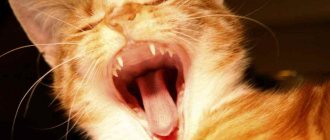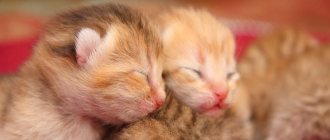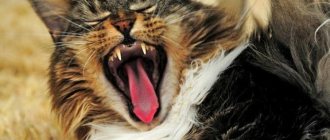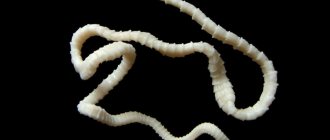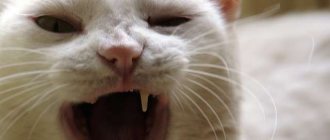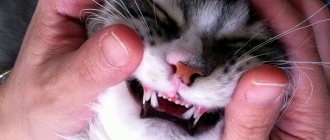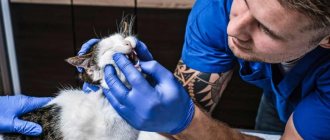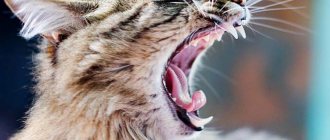Kittens, like other pets, are born without teeth. As kittens grow older, they develop baby teeth one after another, which are eventually replaced by permanent teeth. The process of the appearance and change of teeth usually goes unnoticed for owners, as it usually takes place without any complications.
Knowledge of the process of changing baby teeth to permanent teeth will allow kitten owners to promptly notice and eliminate possible problems in the kittens’ oral cavity.
Formation of a cat's dental bite.
A kitten's milk teeth begin to erupt from the 2nd week of life and finish erupting by 6-8 weeks of age. In total, by the age of 2 months, a kitten has 26 milk teeth, which form the cat’s bite.
The order of eruption of baby teeth in a cat.
The kitten's incisors are the first to erupt at 2-4 weeks of age. At 3-4 weeks of age, fangs appear. Premolars appear in a kitten at the age of 6-8 weeks.
A kitten's emerging baby teeth are thinner than their permanent teeth. The baby teeth will serve the kitten for several months. If the cat has enough milk, and the kittens are given balanced supplementary feeding in a timely manner, there is no lag in weight gain and development, the replacement of milk teeth with permanent teeth will begin at the age of 3–4 months.
How do baby teeth change to permanent teeth?.
The replacement of baby teeth with permanent teeth in a kitten begins at 3-5 months of age and ends at 7-8 months, when 30 permanent teeth form a permanent molar bite. Constant contact and mechanical irritation causes destruction of the roots of baby teeth, which stimulates loosening and their loss.
The process of replacing baby teeth with permanent teeth is usually painless and goes unnoticed for cat owners.
The resulting permanent dentition in a cat is represented by:
- 12 incisors (6 incisors each on the lower and upper jaws).
- 4 fangs (two on each jaw, running along the edges of the incisors).
- 10 premolars (start behind the canines, with 6 premolars in the upper jaw and 4 premolars in the lower jaw).
- 4 molars (2 on each jaw). These 4 molars in the cat are missing in the primary dentition.
The order of replacement of baby teeth with permanent teeth.
The replacement of milk teeth with permanent ones in a cat occurs in the same order as the appearance of milk teeth.
- First, at 4-5 months, the incisors are replaced.
- Then, at 4-6 months, the fangs are replaced.
- At 5-6 months, the premolars are replaced.
- At the end of the 6th month, molars grow.
Symptoms of teething and changing teeth
In most cases, the period of teething and changing teeth in a kitten proceeds almost unnoticed by the owner, but there are a number of symptoms that the owner should pay attention to. And when they appear, for the health of the kitten and your own peace of mind, it is better to visit a veterinarian.
- Refusal to eat or decreased appetite.
If the gums are sore, the kitten may refuse solid food offered. In the event that the refusal to feed continues for more than a day, this should attract your attention.
- The kitten begins to bite toys, bedding, and the owner’s hands. Kitten owners should stop hand biting immediately because... this can lead to him developing a bad habit.
- There is a smell from the oral cavity (cat's bad breath).
In most cases, unpleasant odor from the mouth appears when changing teeth. It is necessary to regularly examine the kitten's oral cavity, paying attention to severe redness or the appearance of ulcers on the mucous membrane.
- The molar has erupted, but the baby tooth has not yet fallen out
A similar situation in kittens occurs quite often and is explained by the fact that the molars grow from a different socket than the milk teeth. That is, physiologically, the molar does not “push out” the milk tooth. This situation shouldn't be scary for a while.
If the teeth in the oral cavity do not interfere with each other, the gums and mucous membrane of the oral cavity are not inflamed, owners should not worry. Not a single kitten in the world has a double set of teeth, which means that your kitten will sooner or later lose its “double set”. But if baby teeth interfere with the growth of molars, inflammation of the gums and oral mucosa occurs, and the teeth injure the tissues of the oral cavity, then the kitten’s owner will need to contact a veterinarian.
Dental care
Caring for your pet's oral cavity is one of the foundations of its health. To avoid dental diseases in a kitten, you need to carefully monitor its teeth. Carefully examine both baby and molar teeth for dirt, bite patterns, or uneven growth. A veterinarian will tell you how to brush your pet’s teeth at home. Also, consult with a specialist about what paste and brush you should buy at a pet store for your kitten.
If you notice a strong odor from your cat’s breath, be sure to consult your veterinary clinic to determine what may be causing this. In addition to poor hygiene, your kitten may be sick with something.
All problems are easier to prevent, so do not hesitate to contact your veterinarian in a timely manner.
Possible complications when changing teeth in a kitten
When changing teeth, a kitten may experience the following types of complications:
Gum inflammation
Teething or the replacement of milk teeth with permanent teeth may be accompanied by a minor inflammatory process, which goes away on its own after the complete formation of the dentition. If you feed your kitten incorrectly, gum inflammation may prolong.
Symptoms. Inflammation of the gums (gingivitis) in a kitten is accompanied by severe drooling (the cat drools). The kitten strives to chew everything. Due to increased soreness of the gums, the kitten's appetite may decrease. Upon visual examination of the oral cavity, we note redness and swelling of the gums.
Treatment. Inflammation of the gums usually goes away on its own after changing teeth. It is necessary to switch the kitten to soft food, which will prevent irritation of the gums.
Residual (“stuck”) baby teeth
In kittens, baby teeth often do not fall out until the permanent tooth emerges from the gums. Residual teeth can disrupt the bite due to abnormal molar growth and cause injury to the cat's gums, cheeks, and lips. In case of such complications, the kitten's owner will need to contact a veterinary clinic.
Symptoms. When examining the oral cavity over the age of 6 months, we find baby teeth.
Beneath the loose baby teeth we find signs of growth of permanent teeth.
Treatment. Veterinary specialists of the clinic, after a clinical examination of the oral cavity, if it is impossible for baby teeth to fall out on their own, these baby teeth are removed surgically under anesthesia.
Baby teeth
Kittens develop their baby teeth first. This happens at about 2-3 weeks of age. As they grow, the number of teeth also increases—a two-month-old baby should have, on average, 26 teeth. Primary teeth are different from molars: they are sharper, thinner and slightly smaller than permanent teeth.
There are four types of teeth in cats:
- Incisors. These are the front teeth located between the canines. The cat mainly uses them to capture prey or food.
- Fangs . They serve to capture prey and are used for protection in the event of a fight with other animals.
- Premolars . With the help of premolars, cats can hold prey and also grind food.
- Molars . They perform the same function as premolars. There are no primary molars, i.e. The pet's molars immediately grow in.
Oral hygiene for a kitten
During the change of teeth, oral hygiene in a kitten becomes important. It is necessary to teach a kitten to oral hygiene from a very early age, so as not to suffer in the future with an adult cat.
They usually start with a game - when the kitten begins to get used to a special toothbrush for animals and stops being afraid of it. The kitten will be happy to grab the bristly brush, especially when his gums itch. The main thing is to do this constantly, then the cat will get used to this hygiene procedure.
This will allow you to avoid problems such as tartar (tartar in cats) and the development of periodontitis in the future.
How to help your pet
An attentive owner manages to notice problems in time and take action. But if it’s not entirely clear why a cat’s teeth fall out before the age of 6, try to independently determine the direction of the search:
- With age-related tooth loss, they fall out in a strict order: first the incisors, then the canines, then the premolars and molars. The loss is extended over time. If this order is broken, then you need to look for another reason.
- If you find wounds on the gums or chipped enamel, take measures to neutralize the consequences of the injury.
- Pay attention to the presence of tartar and caries, a specific (sweet, putrid, sour) odor from the mouth. If the gums have changed color, the crowns wobble or look transparent, gray, or black, this is a direct indication of disease. If you notice these signs, contact your veterinarian for treatment.
Something else interesting: Tartar in cats
What should owners do?
Do cats lose their baby teeth? Of course! If you notice that your pet's teeth have begun to change, there is no need to worry. At this stage of life, it is worth paying attention to the cat’s oral cavity. Every day you need to treat your mouth with a weak solution of Chlorhexidine. A video on how to do this will help you.
Focus on your cat's nutrition. Special foods for growing kittens contain increased amounts of calcium and phosphorus, which are the builders of future teeth.
It would be a good idea to give your pet vitamins for growth. In general, in the first year of life, a cat should constantly be given vitamin supplements, especially if he is fed dry food. Castration should be postponed temporarily so as not to cause increased stress to the body.
Please note that a cat or dog also needs to brush its teeth. This is done with a special paste with an attractive smell. Brushing allows you to remove particles of stuck food from the enamel and prevents the formation of tartar.
Age-related changes in the dental system of cats
The age of cats can be easily determined by their teeth, or more precisely by the degree of their wear. The central and lateral incisors of the lower jaw are the first to wear off; with age, the surface of all incisors takes on a transverse oval shape. The more teeth a cat has, the older it is. The very last to be involved in the process of enamel abrasion are the fangs.
Senile tooth loss, especially the canines, is quite rare in cats and occurs mostly due to improper care. Although it is quite natural that if an animal reaches twenty years of age, it is unlikely that it will have the number of teeth given by nature in its mouth. Most likely, you will definitely miss a couple or three pieces.
What happens in a cat's mouth?
You should also rush to see a specialist if cats suddenly begin to lose teeth in adulthood. Why this happens cannot be answered unequivocally, since what is happening in cats is clearly in the nature of some kind of disorder. In order to help the animal, it is important to find out the root cause of such an unpleasant phenomenon. The most common ones require more detailed consideration.
A cat's mouth is full of bacteria, just like a human's. Among the huge number of microorganisms, the main groups can be noted:
- useful, supporting normal microflora;
- low-harmful, the presence of which does not have a significant impact on the development of diseases;
- pathogenic (active microbes that can promptly provoke the onset of any disease).
The so-called low-harmful ones pose no less a threat to the cat’s body than pathogenic ones. If the number of beneficial microorganisms in the mouth decreases, cats often experience the first signs of slow-onset illnesses. But if tooth loss begins, it means that pathogenic bacteria have taken over, which, being in small numbers, can cause enormous harm to the health of the pet.
Cat jaw structure
Typically, the jaws of cats are well developed and have a peculiarity: the movement of the lower jaw occurs only vertically. The animal bites the food, as if cutting it.
Each tooth has enamel, dentin, pulp and root (1-3), as well as its own role. Let's open the cat's mouth and see that in front there are 12 incisors for holding prey in the mouth.
Next are long fangs, firmly seated in the bone: two below, two above. Their function is to grind food, and they also help in hunting and self-defense.
Behind the canines, premolars and molars are visible, which allow them to chew food and grind bones.
Dental diseases in cats
Sadly, cats are also susceptible to dental diseases:
- Plaque: A soft yellowish or grayish accumulation on the tooth surface. Regular cleaning can help with this;
- tartar: this is already fossilized plaque with a mass of harmful bacteria that will definitely manifest themselves sooner or later;
- caries: in cats it is somewhat different from in humans, but it also brings problems;
- osteomyelitis: the disease can destroy the bones of the jaws and often appears as a complication of caries.
- periodontitis: the gums become inflamed, sensitivity increases, the tooth becomes loose and falls out;
- gingivitis: inflamed gums bleed, swell, painful ulcers form, and there is a high risk of tooth loss.
In addition to the above, cats are susceptible to stomatitis and teeth grinding.
How to notice that a kitten's teeth are changing?
In most cases, owners may not even notice this moment. Especially if small teeth fall out, not fangs. If so, this is good: it means the process is proceeding normally. If not, then you will definitely notice that something is wrong - at least because the cat will eat worse. The problem can also become noticeable externally: if the fangs fall out, they pull back the folds of the mouth - and you will immediately notice that there is something wrong with the cat’s face. Once you open his mouth, you will understand why.
Also, one of the symptoms is increased salivation: the cat may smack its lips and lick itself more often than usual.
In addition, the cat may try to get rid of teeth with its paws. If you notice this, it means that the tooth will soon fall out. But there is no need to help: the kitten will cope on its own, without outside help, which can only do harm, because you do not control your strength and can pull out a tooth that is not yet ready for this. However, if the tooth has almost fallen out, you can help it with a very gentle movement.
The kitten is teething: how to help him
Cutting sharp teeth through sensitive gums always causes physical discomfort, but according to Greencross Vets, it's usually minimal.
The kitten will try to reduce the pain and irritation associated with teething. He may even try to use his owner as a chewing toy, which the latter is unlikely to like. In this case, as during other aggressive cat games, you need to switch the kitten’s attention to something else.
One safe item to use as a chew toy is a cool, damp washcloth. You can chew on it as much as you like, and this will help reduce discomfort. Fabric toys and braided ropes are also suitable.
Alternatively, you can purchase kitten chew toys from a pet store, such as those made from nylon that are easy to chew or those that can be kept in the freezer. For the safety of the kitten, it is better for the owner to be nearby while he plays with these toys. In all cases, you should follow the manufacturer's instructions and check toys for integrity, immediately discarding damaged ones.
The kitten may try to chew furniture legs or wires. Such actions can not only lead to damage to things, but also cause harm to the pet. “To prevent accidental injury from destructive chewing, cover electrical cords and wires with protective plastic covers,” advise Your Cat. They also suggest placing double-sided tape on the areas you want to protect from your kitten's sharp teeth.
Care and feeding
Changes in teeth in cats can make themselves felt as early as six months later, so owners should know how to properly care for their pet so that the process goes faster and less painfully. It is important to monitor the behavior of British cats and representatives of other breeds, preventing them from chewing furniture, shoes and other objects in the house. As a relief, the kitten is capable of biting the owner's fingers or toes, but this should not be allowed, since the habit can become a serious problem in the future. During the period of teeth change, it is worth observing a special diet, adhering to the following recommendations:
To ensure a sufficient amount of calcium for the animal’s body, it is recommended to include cottage cheese in its diet.
- Avoid very soft food, since the kitten may inadvertently swallow lost teeth, resulting in damage to the esophageal mucosa. It is recommended to introduce food of coarse consistency and large size into the diet.
- The meat is given in large pieces, with preference given to beef, turkey, and chicken. You first need to scald or boil it.
- Add cottage cheese and other fermented milk products, which contain a lot of calcium, to your daily diet.
- It is possible to add drops or small tablets of phosphorus to the main diet. It is possible to purchase such drugs at a veterinary pharmacy, and many of these drugs contain a small analgesic substance that eliminates pain when changing teeth.
- Twice a week the kitten is fed boiled sea fish, for example, hake.
- The diet is replenished with foods filled with vitamins A and D.
- It is recommended to let the kitten chew on special bones, which are previously purchased at a pet store. They consist of vitamin supplements, thanks to which you can not only scratch your gums and strengthen your growing teeth, but also get the necessary vitamins.
What symptoms accompany tooth loss?
A cat's tooth can fall out for various reasons. If this happened due to injury, there may not be specific symptoms. However, if a pet who has lost a tooth experiences changes in behavior and other signs, this should be a cause for concern and seeking medical help.
Symptoms that may accompany tooth loss:
- copious amounts of saliva;
- swollen gums;
- redness of the gums;
- bleeding from the gums;
- the presence of ulcers in the oral cavity;
- presence of pus in saliva;
- increased excitability, aggression, irritability;
- refusal of food and drink;
- having difficulty chewing;
- bad breath.
If your cat has lost a tooth, you should not ignore it. This may be a sign of a serious pathology. The spread of infection in the oral cavity can cause serious diseases of the internal organs.
Signs of oral health
The protection provided by beneficial microbes is reduced to zero if they die. This factor is decisive in creating the most suitable conditions for the proliferation of pathogenic microorganisms. The first symptoms of this are:
- redness of the gums;
- swelling;
- bleeding;
- formation of dental plaque.
Periodontitis as a cause for concern
By the way, the last sign of the development of pathology in cats is a serious signal that it is time to take measures to prevent more severe consequences in the future. Formed tartar due to dental plaque not removed in a timely manner often becomes the cause of such an ailment as familiar to humans as periodontitis. The main therapeutic measures here will be the removal of accumulated stones from the tooth surface. Although often in cats, treatment ends with tooth extraction.
The development of the disease can only be prevented with careful oral care. You need to monitor the condition of your cat’s teeth and gums regularly, and if you identify the first suspicions, immediately go to the doctor.
